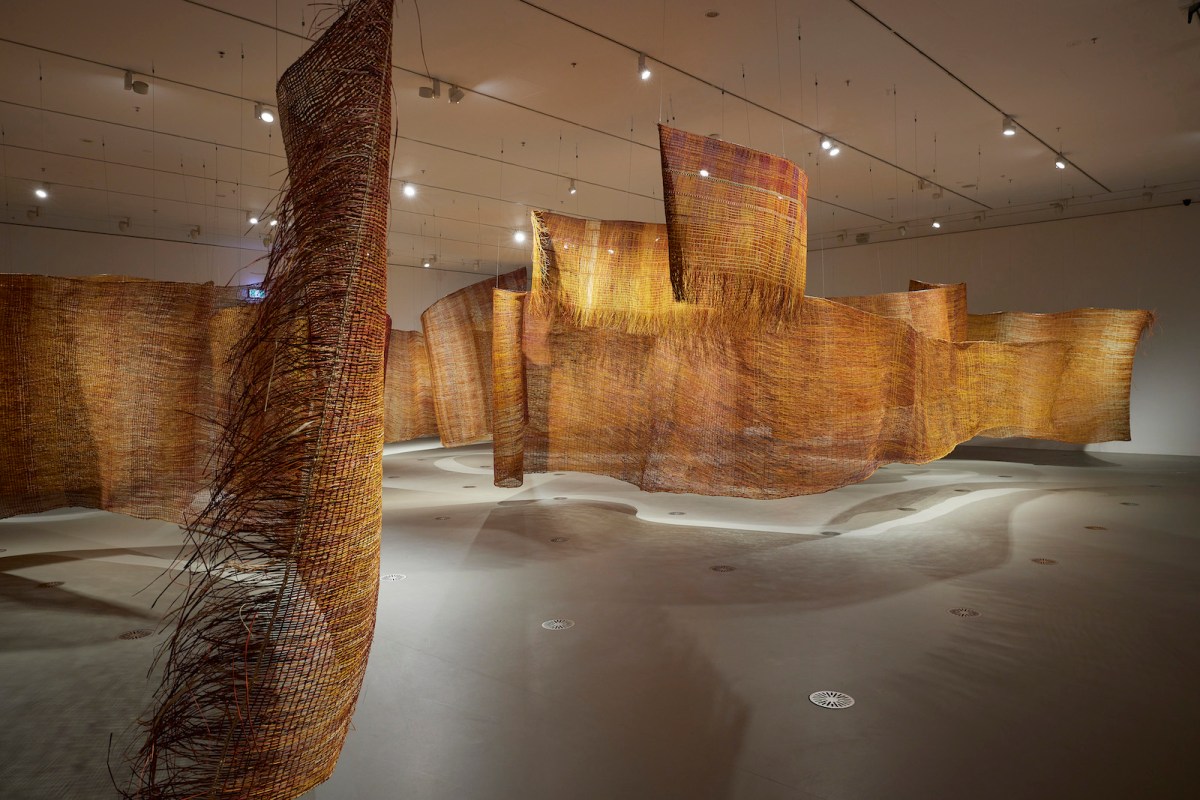It is the season of big exhibitions. And over its short history the National Gallery of Victoria (NGV) Triennial has garnered a reputation as one of the biggest. For its first edition in 2017, it drew a crowd of 1.23 million visitors. Its second edition, which was hampered by pandemic closures, still drew more than 500,000 at a time when people were reticent to visit venues.
Launched on Friday (1 December) at NGV International, this year’s Triennial is geared to follow suit. Around 120 artists have delivered over 100 new projects – 75 of which will remain in the Gallery’s Collection. There was $8.5 million raised to commission these new works, ensuring a legacy beyond the exhibition.
It is all impressive data, but does the show deliver?
Jump to:
Tone from the outset
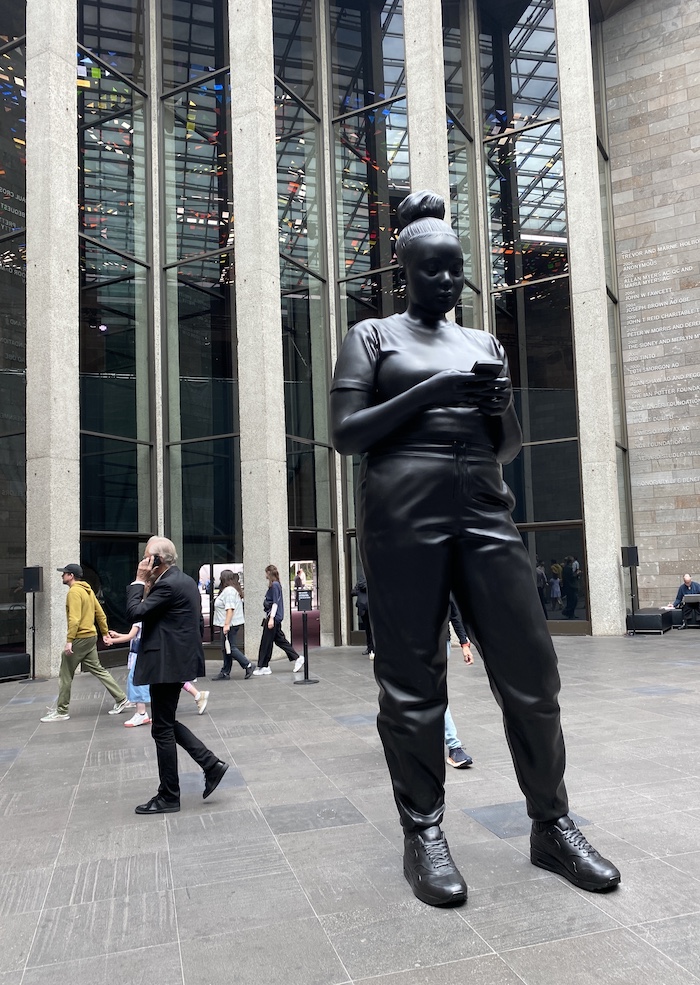
If anything gives us a hint of this edition’s tone, it is Thomas J Price’s two “sculptures of statues” (as he calls them) that stand around three metres tall in the Gallery’s entrance, Federation Court – All In (2021) and Reaching Out (2020). Larger than life, they shout, “Hey, I’m not invisible”. They are black, anonymous and everyday.
Price confronts the lack of people of colour (POC) represented in public statues in the UK – their inclusion having a resonance here as Australia emerges from a “No” referendum. They depict a girl texting and, a small distance away, a boy with hands in pockets – both self absorbed.
It is a very different assertion than Refik Anadol’s tech masterpiece, Quantum memories (2020), which sat in the same spot in NGV Triennial 2020. But it is a tone of self asserted identity that is picked up and carried forward in the exhibition, by artists Hugh Hayden (US), Tiff Massey (US), Hank Willis Thomas (US), Diedrick Brackens (US), photographer Tyler Mitchell (US) and First Nations artist Danie Mellor (Ngadjon/Mamu), who repositions the colonial gaze.
From social to spectacular, different hooks for different audiences
The spectacular, however, is not ignored. Alongside Price occupying Foundation Court is Julian Charrière’s video, And Beneath It All Flows Liquid Fire (2019) – an enigmatic work of a burning fountain.
It is beautifully placed against the Gallery’s entry curtain of water as a backdrop – the elements of fire and water in a joust between destruction and life source. Charrière has emerged out of the mega studio of Olafur Eliasson (no surprises there), and his work taps an Australian psyche with emotions still not far from the surface from bushfire tragedies.
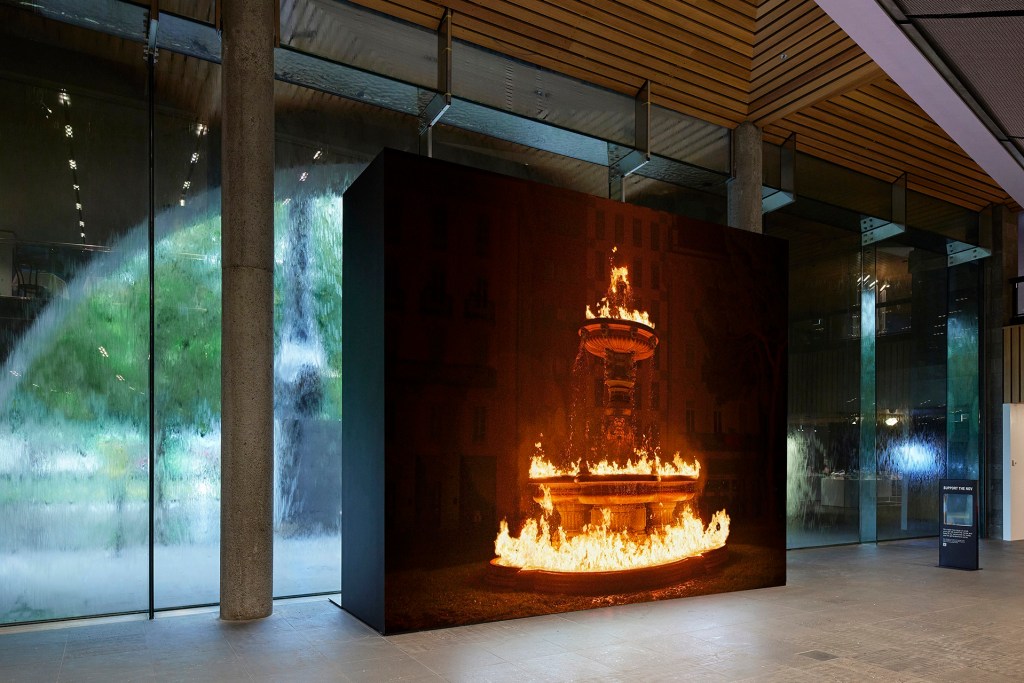
This sense of spiralling doom at our hands is a recurrent concern in further works, including John Gerrard’s Flare (Oceania), a generative version of a seascape from Tongan photographer and eco-activist Uili Lousi, with an urgent message of rising sea levels.
This kind of epic narrative across time is picked up by Dutch collective SMACK, with its three-channel video, Speculum (2019), which is a recreation of Hieronymus Bosch’s iconic early 16th century painting, The Garden of Earthly Delights. Only here, vanity, screen addiction and greed stand in as our contemporary sins. It will be a sure people-pleaser for Triennial visitors.
These two themes – agency over one’s identity as a POC, and our climate response in the face of a spiralling crisis – weave across all levels of the Gallery, and are often juxtaposed with historic Collection works. While this is a pretty standard curatorial practice today, it does have some magic high points in this Triennial.
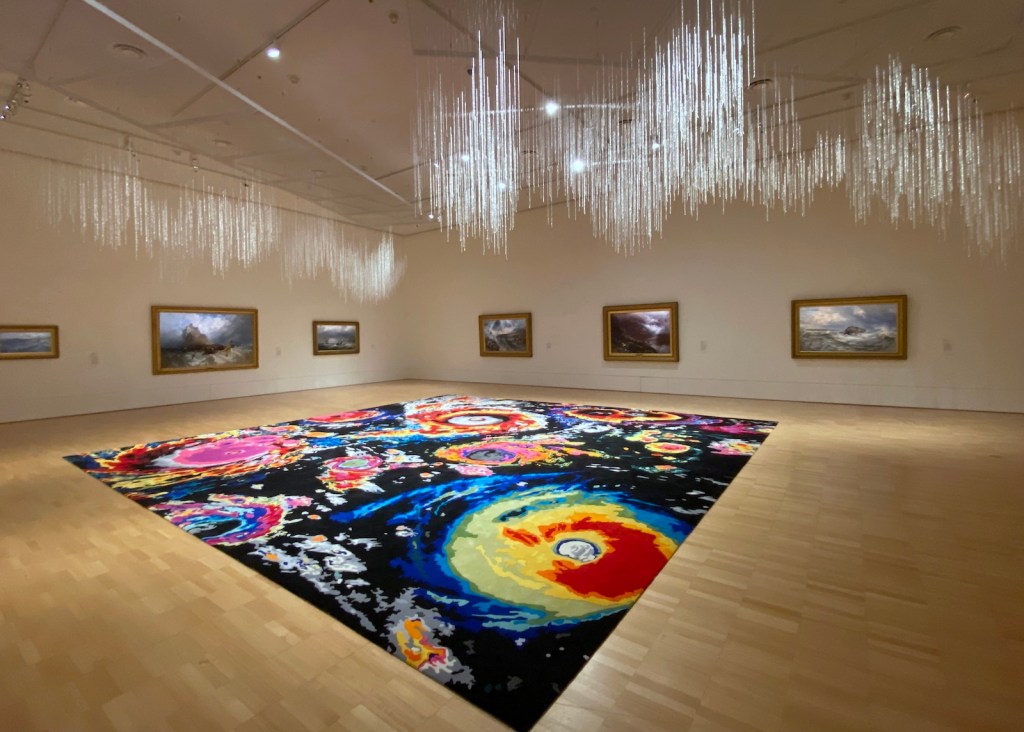
Take for example, Franziska Furter’s climate carpet Liquid Skies/Gyrwynt (2023), which depicts a composite of multiple infrared satellite images, and its shower of glass beads overhead, Haku (2023). They are surrounded by wild seascapes by J M W Turner, Clarkson Stanfield, Keeley Halswelle and Henry Moore – the tension between beauty and terror in Furter’s carpet echoed in the Collection works.
The sociopolitical pulse continues across this Triennial with works by Ashley Jameson Eriksmoen (Australia), Lin FangLu (China), Petrit Halilaj (Kosovo) and Kevin Abosch (Ireland), among others.
Perhaps one of the strongest works for this edition is the incredible installation by Mexican artist, Fernando Laposse, Conflict Avocados. A 40-metre long narrative textile – the Cherán Tapestry – dominates the space, as well as furniture made from avocado skins and a video that looks at the avocado trade and its environmental and social impact, fuelled by contemporary demands.
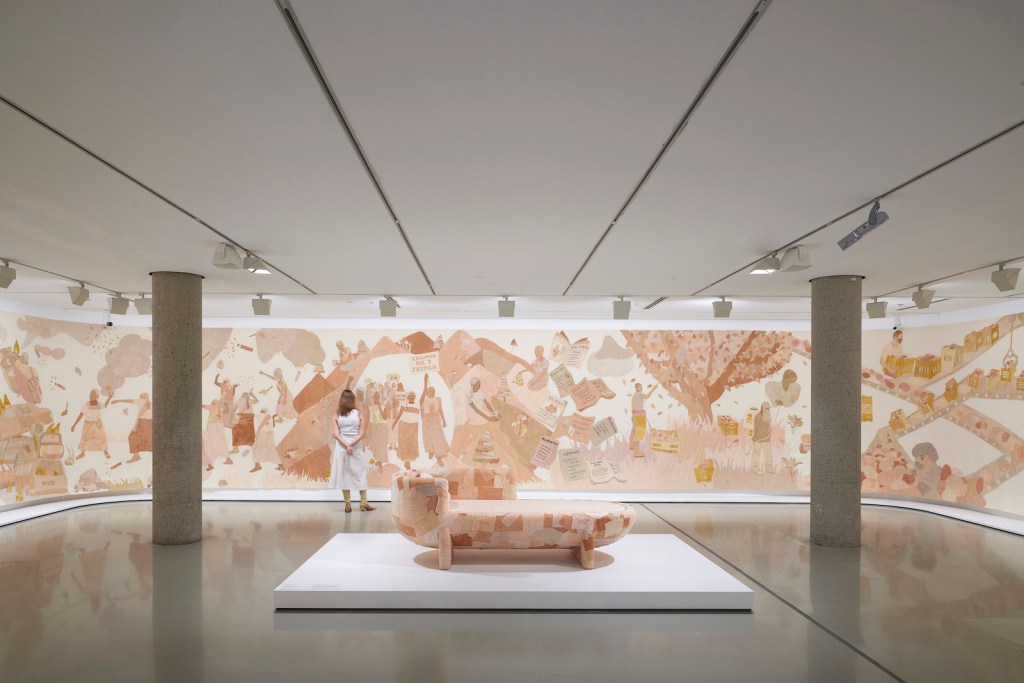
Legacies and materiality
The Gallery explains that the exhibition is curated around three thematic pillars: Magic, Matter and Memory. As a viewer, however, I would argue they are hardly felt as either tools to navigate people or clustered ideas. Rather, as in past editions of the exhibition, Triennial works are interwoven with the Collections, and reach across all three levels of the Gallery – the connecting points more ones of material and moment.
What is significant about this exhibition is its weighty tip toward expanded textiles. It is great to see US-born, Paris-based sculptor Sheila Hicks celebrated with the inclusion of her work, Nowhere to Go (2022) – a stacked sculptural installation of “boulders” of blue fibre. It is presented alongside two senior First Nations women with new commissions – a huge painting by Betty Muffler and a suite of inks by Iluwanti Ken.
Their very proximity poses a de-siloed conversation in abstraction, and a nod to senior women artists overlooked. This is asserted earlier in the exhibition, with the work chosen to enter the lower-level galleries – a collective piece by 13 women artists from Arnhem Land. Viewers weave in, through and around the 100-metre Maningrida Fish Fence, Mun-Dirra, which is beautifully suspended in the space. Two years in the making, it reminds viewers that Burarra people have lived sustainably with the lands and waterways for generations.
It is a nice throughway from the newly commissioned permanent outdoor sculpture for the Gallery’s moat, a bronze eel trap by Wurundjeri artist, Aunty Kim Wandin. It riffs off the matrilineal practice of basket weaving with the heavy weight, bronzy (and add bloke-ish) bravado of public sculpture.
Other standout works that explore legacies and knowledge are the Yee I-Lann (Malaysia) installation of tikar (woven mats) and Hugh Hayden’s classroom of anthropomorphic sculptures that question the idea of upward mobility starting with education and leading to social and cultural assimilation.
That kind of regearing – rethinking – is, perhaps, the greater outcome of NGV Triennial 2023. Sure, there are those spectacular immersive moments, and big-name drawcards; however, this feels like a quieter, slower blockbuster exhibition.
What, then, are the big drawcards that will pull audiences?
This exhibition does have its share of big names – some of the biggest being Yoko Ono and Tracy Emin, and the much-publicised robot dogs by Polish-born, LA-based artist Agnieszka Pilat and her case for empathy with AI-enabled animatronics (which ArtsHub will look at in a separate story).
Outside the Gallery, Ono’s text-based billboard style work on the façade declares, I LOVE YOU EARTH, while David Shrigley’s (UK) sculpture Really Good (2016) – which featured at London’s famous Fourth Plinth at Trafalgar Square and was made in the immediate aftermath of Brexit – offers a thumbs-up … or is it, somehow, a raised finger?
What is certain is that Shrigley (returning as a favourite of the Gallery) brings a larkish irreverence to the Gallery space that is loved by many. This is taken to another level by Maurizio Cattelan’s (Italy) duct-taped banana, Comedian, (2019), which is given its own gallery space and is, I’d argue, a waste of real estate.
This push and pull between respect, irreverence and visibility is an interesting foundation, however, and one I find most intriguing in this Triennial.
Other highlights include the immersive video project Megacities which, across a flotilla of 19 suspended video screens, sees 10 street photographers look at 10 cities with populations in excess of 10 million people, at once humanising them, but also revealing their pressure points. It is an incredible project and the installation is absorbing.
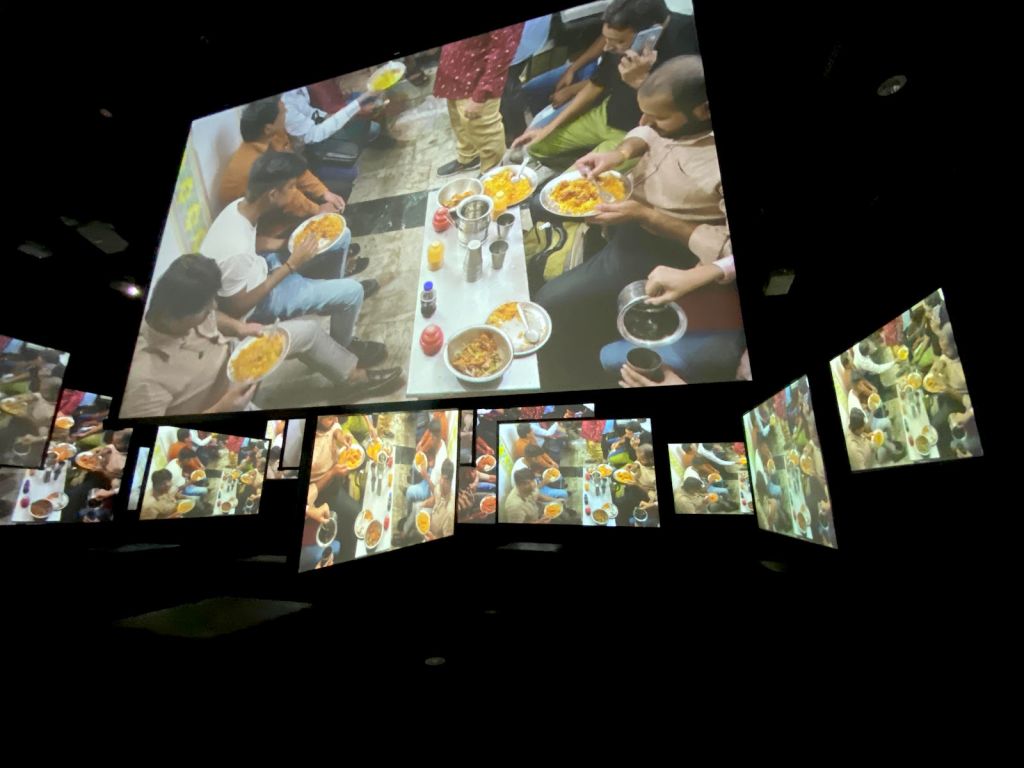
Read: Repositioning Emily Kam Kngwarray, and why now
Also worth seeking out is Tokyo-based artist Azuma Makoto’s room-sized installation of 130 flowers encased in acrylic blocks. A video, central to the room, animates them in a cycle of life and death. In total contrast, but equally “candy” to audiences is dancer-cum-Tik Tok sensation, Smac McCreanor’s café intervention of video “episodes” of squished objects echoed by her own bodily movements… and then, of course, there’s Ryan Gander’s tiny animatronic mouse, which offers a delicious point of difference in scale and spectacle to projects such as Megacities and Yoko Ono’s participatory work, MY MOMMY IS BEAUTIFUL, which feels a bit vacuous.
As with all exhibitions of this scale it is impossible to give credit where it’s due to all the artists showing – and this is a dynamic and diverse exhibition. Does it feel thin? Does it feel too discombobulated? No. In many ways, this exhibition has found its own blend of materials, names and ideas – a hard thing to get right when working on exhibitions of this scale. Great summer viewing.
NGV Triennial 2023
NGV International, Melbourne
3 December 2023 – 7 April 2024
Entry is free.
The writer travelled to Melbourne as guest of the National Gallery of Victoria.
